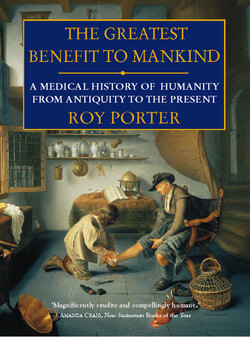Читать книгу The Greatest Benefit to Mankind - Roy Porter - Страница 48
NEW ARRIVALS
ОглавлениеIslam brought new medical practices to India, having a major impact after the eleventh-century Turco-Afghan invasions of Gujarat, and becoming entrenched especially around Lahore, Agra, Lucknow and Delhi. These were known as Yunani Tibb – Yunani (or unani) being an Indian representation of the word ‘Ionian’. Yunani medicine derives in large part from Galenic medicine as interpreted in Ibn Sina’s Al-Qanun fi’l-tibb [Canon], and continues to flourish in India today. It is practised by hakims (physicians) in rural areas especially and is advocated among those who wish to embrace a distinctively Islamic medicine.
Yunani medicine and Ayurveda have interacted to some degree, especially in materia medica. Though the primary languages of Yunani medicine are Persian and Arabic, there are also certain Sanskrit texts. Yunani postulates four basic humours, as distinct from Ayurveda’s three, and it has more of an orientation towards treatments in hospitals. The major difference between them is their clientèle. Broadly, Yunani physicians treat Muslim patients, and Ayurvedic physicians treat Hindus.
In the first half of the sixteenth century Portuguese settlers came to Goa. The first medical book printed in India was the Coloquios dos Simples, e Drogas he Cousas Mediçinais da India (1563) [Colloquies on the Medical Simples and Drugs of India] by Garcia d’Orta (1490–1570). D’Orta had gathered his material from local physicians, and the signs are that there was a free exchange of medical ideas at that time between the Portuguese and the Indians. Relationships however declined, and after 1600 the Portuguese introduced restrictions which in effect banned Hindu physicians in Goa.
Dutch East India Company officials showed great interest in the natural history and medicines of the Malabar coast where they traded and settled. Heinrich van Rheede (1637–91), the Dutch governor, published between 1686 and 1703 a work containing nearly 800 plates of Indian plants. Paul Herman’s (1646–95) herbarium and Museum Zeylanicum provided major sources for Linnaeus’s Flora Zeylanica (1747).
The British arrived around 1600. Facing unfamiliar and severe health problems, East India Company traders were keen to learn from the local vaidyas and hakims, and Indian doctors were curious about British surgery, since the art had lapsed among vaidyas. It was observed by Sir William Sleeman (1788–1856) that ‘the educated class, as indeed all classes, say that they do not want our physicians, but stand much in need of our surgeons.’
British physicians were initially prompted to adopt Indian methods by the problems involved in shipping medical stores from Europe. In time, however, they grew increasingly critical of the crudeness of indigenous drugs and contemptuous of what they saw as the shortcomings of Indian medicine. With characteristic ethnocentricity, East India Company attitudes towards Indian medicine hardened. When medical colleges had been founded in Bengal and elsewhere under the British Raj, the study of Ayurveda was given a semblance of support alongside British medicine; but with changes in educational policy after 1835 and the suppression of Ayurvedic teaching in state-funded medical colleges, British support for Ayurvedic training ceased. Ayurvedic physicians continued to practise, although their training was reduced to the traditional family apprenticeship system.
In the twentieth century, with the rise of the Indian independence movement, indigenous traditions received active encouragement from nationalists. In recent decades there have been divided loyalties: since independence in 1947, the Indian government has oscillated between commitment to western medicine in the name of progress, and acceptance of the fact that Ayurvedic medicine is widely practised, especially in the countryside, and commands sturdy loyalties. Many Indian physicians have a strong incentive to devote themselves to western medicine – it is a passport to practise throughout the world.
In 1970, the Indian Parliament passed the Indian Medicine Central Council Act, setting up a central council for Ayurveda. Since then government-accredited colleges and universities have provided professional training and qualifications. This training, however, includes some basic education in western methods, family planning and public health. In 1983, there were approximately one hundred officially approved Ayurvedic training colleges, many attached to universities. But although the number of Ayurvedic and Yunani colleges and dispensaries has multiplied since independence, government funding has been minimal. Popular perception is said to be that the students in the indigenous medical schools failed to gain admission to modern western medical or professional universities.
The traditions combine and are rarely exclusive. Private Ayurvedic practitioners make use of modern western treatments, often on the wishes of their patients: western-style injections are widely regarded as a powerful, almost magical cure. In a small 1970s study of fifty-nine indigenous practitioners in Punjab and Mysore, researchers found that the vast majority of drugs being used were antibiotics and similar western medicines. The idea that Ayurvedic physicians deal purely in herbs, roots, and therapeutic massage is a nostalgic myth. Today in India, the patient may take any of many available paths towards greater health. There exist side by side physicians of cosmopolitan medicine, Ayurveda, and Yunani, as well as others such as homoeopaths, naturopaths, traditional bone-setters, yoga teachers and faith-healers.
The trend, however, is towards the greater assimilation of western medicine, especially among the wealthy and cosmopolitan. It is noteworthy that Ayurvedic medicine has not yet achieved the vogue in the West acquired by Indian philosophy and (thanks to fascination with acupuncture and the yin-yang system) by Chinese medicine.
